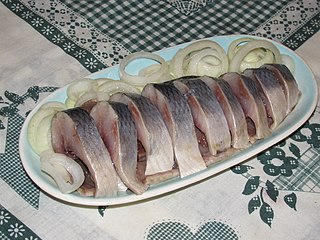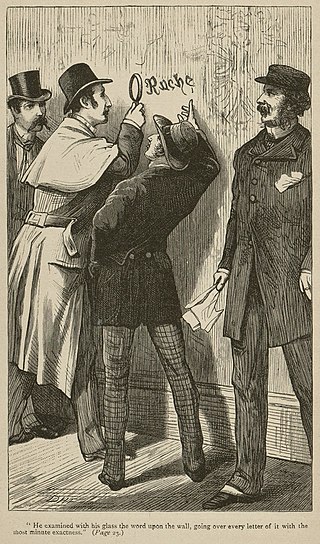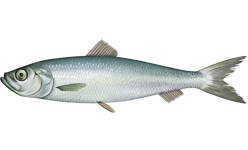
Clupeiformes is the order of ray-finned fish that includes the herring family, Clupeidae, and the anchovy family, Engraulidae. The group includes many of the most important forage and food fish.

Herring are various species of forage fish, mostly belonging to the family of Clupeidae.

Larus is a large genus of gulls with worldwide distribution.

Pickled herring is a traditional way of preserving herring as food by pickling or curing.

Sprat is the common name applied to a group of forage fish belonging to the genus Sprattus in the family Clupeidae. The term also is applied to a number of other small sprat-like forage fish. Like most forage fishes, sprats are highly active, small, oily fish. They travel in large schools with other fish and swim continuously throughout the day.

A red herring is something that misleads or distracts from a relevant or important question. It may be either a logical fallacy or a literary device that leads readers or audiences toward a false conclusion. A red herring may be used intentionally, as in mystery fiction or as part of rhetorical strategies, or may be used in argumentation inadvertently.

Bathyclupea is a genus of ray-finned fishes belonging to a small family Bathyclupeidae.

Lipoamide acyltransferase component of branched-chain alpha-keto acid dehydrogenase complex, mitochondrial is an enzyme that in humans is encoded by the DBT gene.

Europolemur is a genus of adapiform primates that lived in Europe during the middle Eocene.
The Five Stars is a family pop band who has recorded many albums of well known and original Samoan and pacific songs. The reference of "Five Stars" in the band's name denotes the five stars on the national flag of Samoa. With more than 18 albums in production, they sit alongside Punialava’a and Tiama’a as some of the Pacific's most well known bands.
Herring gull is a common name for several birds in the genus Larus, all formerly treated as a single species.

Opisthonema is a genus of herrings, the thread herrings, found in tropical waters of the Western Hemisphere. They get their name from a filamentous nature of the last ray of the dorsal fin. Currently, five species are in this genus.

Herring are forage fish in the wild, mostly belonging to the family Clupeidae. They are an important food for humans. Herring often move in large schools around fishing banks and near the coast. The most abundant and commercially important species belong to the genus Clupea, found particularly in shallow, temperate waters of the North Pacific and North Atlantic Oceans, including the Baltic Sea, as well as off the west coast of South America. Three species of Clupea are recognized; the main taxon, the Atlantic herring, accounts for over half the world's commercial capture of herrings.

Clupea is genus of planktivorous bony fish belonging to the family Clupeidae, commonly known as herrings. They are found in the shallow, temperate waters of the North Pacific and the North Atlantic oceans, including the Baltic Sea. Two main species of Clupea are currently recognized: the Atlantic herring and the Pacific herring, which have each been divided into subspecies. Herrings are forage fish moving in vast schools, coming in spring to the shores of Europe and America, where they form important commercial fisheries.
Lelei Alofa Fonoimoana, also known by her married name Lelei Moore, is an American former swimmer who competed in the 1976 Summer Olympics in Montreal, Quebec.

Alofa Alofa is a Samoan international rugby union footballer who plays as a centre for Harlequins in the English Gallagher Premiership.

Dufouriellini is a tribe of minute pirate bugs in the family Anthocoridae. There are about 7 genera and 15 described species in Dufouriellini.

Lyctocoridae is a reconstituted family of bugs, formerly classified within the minute pirate bugs of the family Anthocoridae. It is widely distributed, with one species, being cosmopolitan.

Hermatobates is a genus of wingless marine bugs placed as the sole genus in the family Hermatobatidae that are sometimes known as coral-treaders. They are quite rare and known only from coral reefs in the Indo-Pacific region. During low tide, they move over the water surface not unlike the more familiar water-striders around coral atolls and reefs and stay submerged in reef crevices during high tide.















